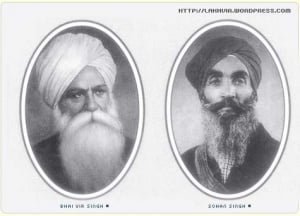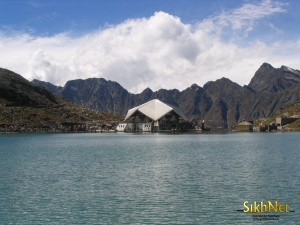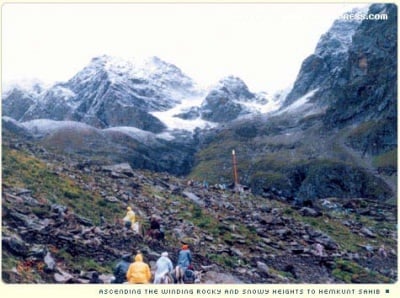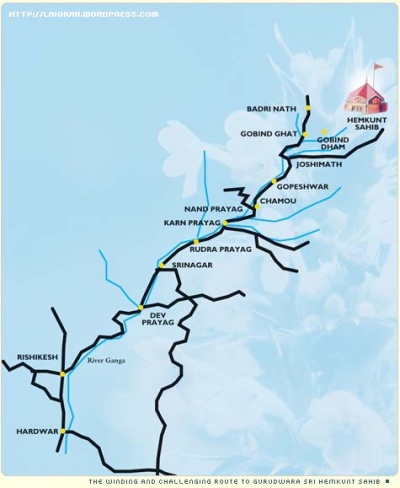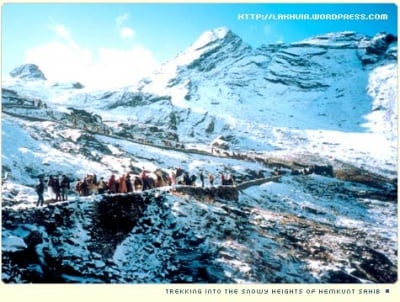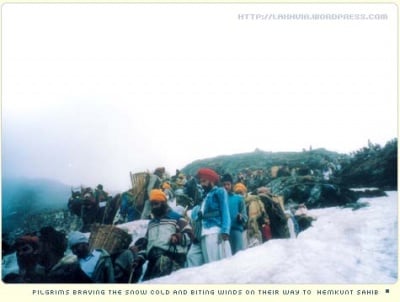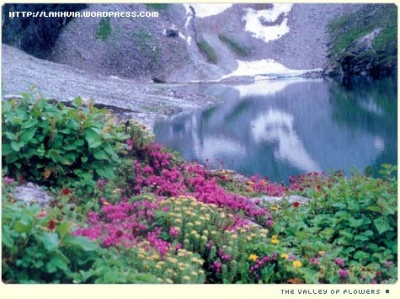Discovery of Hemkunt sahib
The Sikhs started to search for Hemkunt sahib, the “Tap Asthan” (the place of meditation) of their tenth Guru, in the late nineteenth century, even though the shrine is mentioned in the Dasam Granth which was finalised in the 1730’s. The first Sikh to trace the geographical location of Hemkunt was Pandit Tara Singh Narotam in 1884. He was a nineteenth century Nirmila scholar. His findings were published by the renowned exponent of Sikh history and scholar, Bhai Vir Singh in 1929 in his book called “Sri Kalgidhar Chamatkar”.
This book was then read by Sant Sohan Singh, who was a retired Granthi (priest) from the Indian army working voluntarily at a gurdwara in Tehri Garhwal. Having read the description of where the "Tap Asthan" was, he set out to find the physical spot in 1933. Unfortunately he had no luck that year and so he attempted his search again the following year. His enquiries led him to the place known as Lokpal to the local folk.
The description matched that of the place described by the Guru as "Sapat Shring" and the place where King Pandu was believed to have meditated. Sohan Singh believed that Hemkunt had been found. However Sohan Singh’s discovery was met with much scepticism, so he approached Bhai Vir Singh (1872-1957) whose work had inspired him to search for the Tap Asthan. Both Sohan Singh and Bhai Vir Singh met, and visited the site, and both were then convinced that the Guru's description of Tap Asthan matched the site found.
First Gurdwara completed
Bhai Vir Singh then committed himself to developing Hemkunt Sahib. He gave Sohan Singh some money, believed to be an amount of 2,100 rupees, with which to buy some supplies and materials to start construction of a small gurdwara on the shore of the lake. Sohan Singh publicized the cause and was able to collect further funds.
In early 1935 whilst purchasing materials in Mussoorie, Sohan Singh met Modan Singh a Havaldar from the survey department who later accompanied him to the site of construction, then joined forces with him. After obtaining permission from the local people, they hired a contractor and started work on the construction of a ten foot by ten foot stone Gurdwara. Construction of this Gurdwara was completed in 1936. At the same time, they also enlarged the ancient Hindu Mandir that stood on the lake shore as a symbol of respect.
The Development Team got bigger
On retirement from the military, Havaldar Modan Singh dedicated the rest of his life to the service of Sri Hemkunt Sahib. Before Sohan Singh died he entrusted Modan Singh with the duty to continue with the mission of developing Sri Hemkunt Sahib. One of the first structures at Gobind Dham was a tin shed built by Modan Singh. Prior to this construction he took refuge from the cold and the rain in the hollow of a tree trunk; such was the dedication and sacrifice of this man. Incidentally the tree still stands in the courtyard of Gurdwara Gobind Dham. Shortly before his death in 1960, Modan Singh established a seven member trust to oversee the further growth and operation of the pilgrimages.
Inspiration for building a larger Gurdwara emanated from a house-wife in Punjab called Mata Ram Kaur. She had a vision of Guru Gobind Singh who had given the mission to lay its foundation stone. She was able to convince the management of her sincerity by describing details of Hemkunt that she could not have known as she had never been there before. Plans for a new Gurdwara were made in 1964, and construction was underway in 1968 once an accessible road was extended to Gobind Ghat.
New Gurdwara constructed
The new Gurdwara was to take the image of an upside-down lotus flower. The roof structure was built to withstand heavy snowfalls and the doors on all five sides depict a Sikh belief that all people are welcome to praise God in a Gurdwara from all faiths and from all directions because God is all around. The Sikh faith is all about tolerance and not prejudice towards all religions and faiths. It is also a belief that if one reaches out to God in prayer blessing may come from any direction, north, east, west, or south.
Finally, construction of the upper storey of the gurdwara was completed in 1993. The Guru Granth Sahib (the religious scriptures of the Sikhs, and the last and living Guru) was installed in 1994. There is continuous Seva (religious voluntary work encouraged in the Sikh religion) by Sikhs and non-Sikhs to make sure the route to Hemkunt is accessible. One such project called “Safai Seva”(cleaning-up) was started by a young Canadian woman called Heather Michaud, who was then a university under-graduate.
She encouraged other university students and visitors to participate in cleaning up the environment and to stop littering along the route to Hemkunt Sahib. The project set up dustbins and posters along the way to encourage people to dispose of their rubbish in an environmentally- friendly manner. The Sri Hemkunt Sahib Management Trust has continued this work and the State Government have contributed further by banning the use of polythene bags.
Safai Seva has certainly drawn public awareness to keep the Guru’s Asthan litter-free. Gurdwara Hemkunt has special significance to the Sikhs as it commemorates the Guru’s mission and the need for a physical remembrance is beautifully described by the words of Bhai Vir Singh as:
“The traveler passes by leaving behind his footprints. These footprints vanish with the passage of time. But some foot prints are so important that people worship them and make monuments there, which keep conveying their historical importance from generation to generation. These footprints become imperishable.”
Hemkunt Yatra
The pilgrims set off from Amritsar on the 23rd of August 1952, passing through Hardwar, Rishikesh, Srinagar, Gobind Ghat, Gobind Dham, reaching Sri Hemkunt sahib on the 31st August at 2.30 p.m. Their sacred journey complete, the pilgrims cherished Darshan (sight) of the sacred place. They all had Ishnan (holy bath) in the sacred waters of the Sarovar. During the next few days Congregational prayers, which included the singing of devotional Shabads (hymns) and verses were recited throughout the day and night. Having accomplished their first pilgrimage, they arrived at Amritsar on 16th September 1952 and were given a rousing welcome. The numbers of pilgrims to Hemkunt Sahib have been multiplying from the time of discovery until the present day. In 1977, the first year for which data is available, there were 516 Sikh visitors and by 1990 there were 189,340 and the numbers keep growing.
A yatra or pilgrimage to Sri Hemkunt Sahib is only possible during the months of June to October every year due to severe weather conditions in the Himalayas. From the plains at the foothills of the Uttrakand Himalayas there are several stopping points on the way to Hemkunt Sahib where pilgrims can find accommodation. Of these there are two important stops that shall be described. These stopping points can be accessed from the towns of Hardwar (the gateway to God) or from Rishikesh. The first stop is called Gobind Ghat and the second is Gobind Dham. Hemkunt is approximately seven kilometers away from Gobind Dham. A typical Yatra can take up to forty days if one does the whole journey solely by foot. However if one combines a foot Yatra with other modes of transport available like motor vehicles, scooter, mules, or horses, then the journey takes but a few days.
For those pilgrims going to Hemkunt Sahib, the journey is not just a physical one, for most it is an emotional experience. Every step is a step closer to a spiritual awakening or goal. For many the personal significance of the toil to reach the top is an indescribable devotional achievement, for others it is a step closer to prayers being answered and for most, a step closer to God. The beautiful scenery, the historical sites along the way, the mythological significance and the physical challenge to reach Hemkunt Sahib are aspects of the Yatra all visitors, believers or not, share. The mystical and spiritual ambience of the whole journey starts at either Hardwar or Rishikesh.
Both these towns lie on the banks of the holy River Ganges where the plains meet the foothills. Sikh Gurdwaras managed by the Trust to oversee the operations of pilgrimages to Hemkunt Sahib offer free food and lodging in Hardwar, Rishikesh, Srinagar, Joshimath, and Gobind Dham. From the towns one has to travel through the valley in which the Ganges flows and pass the Panch Prayag which is five sacred confluences where major tributaries join the Ganges. The route continues past the holy river Alaknanda tracing the path Hindu pilgrims follow to Badrinath (a sacred shrine to the Hindus).
Gobind Ghat
Approximately 250 kilometers later, equivalent to an approximately twelve hour drive by truck, bus, scooter, and still along the river Alaknanda there is the village of Gobind Ghat. Gobind Ghat is a village that is temporary in nature only existing during the months of June to October. It is named after Guru Gobind Singh in whose memory the pilgrimage takes place, and the word “Ghat” describes the steps from the village leading into the holy river, for those who wish to bathe in their waters for spiritual cleansing. The actual path towards Hemkunt Sahib starts near the suspension bridge crossing the river Alaknanda. A large Sikh Gurdwara complex is situated by the roadside to accommodate visitors of all casts, creeds, races, and colours. The facilities are simple, and there is Langar (free community Kitchen serving vegetarian food) for all. The Sikh faith does not condone discrimination.
Most people travel in groups otherwise known as Jathas, and the atmosphere is euphoric. A very obvious sense of community spirit takes over and can be felt all around. This spirit encourages the pilgrims during the journey when they tire or when the physical strain becomes apparent. However, for those who wish, there are colourful modes of transport to ease the journey ranging from ornately decorated mules, horses and or wooden sedan chairs that are carried on poles or even a ride in a Kandi basket. All these are managed and operated by Nepali porters only to happy to help.
From Gobind Ghat, pilgrims cross the suspension bridge to follow a steep stone footpath that zig-zags into the hillside. Approximately two kilometers into the path, it levels out to follow a stream flowing from the Valley of Flowers (a national Park) and the Hemkunt Lake, which then spews out into the river Alaknanda. All along the path there are plenty of temporary structure and tea shops selling snacks and refreshments. To add to the color, there are devotional Sikh messages tacked to the trees and shops and painted on rocks to inspire the pilgrims and remind them of the significance of their journey.
The Jathas also chant hymns and devotional messages, either to the music of drums played by members, or to the rhythm of the pilgrim’s footsteps. Others play devotional hymns on cassette players while others pray all the way. Most lips utter the sacred word . . . “Waheguru, Waheguru”(wondrous God) . . . “Satnam, Satnam”(Name of God is truth) . . . . When descending pilgrims pass ascending pilgrims they greet each other with the sacred words . . . “Waheguruji Ka Khalsa, Waheguruji Ki Fateh” ( the Khalsa is God’s, Victory is God’s). Love and respect for each other, and hospitality is apparent because all groups and individuals share snacks, distribute glucose powder, sweets, fruits, and drinks with each other.
Some five kilometers from Gobind Ghat at approximately 2,592m, the first snow peaks come into sight, and some three kilometers further on comes the village of Bhyundar where there is a bridge over the Lakshman Ganga Stream. Most pilgrims take a rest here to replenish lost energy and catch their breath. The final three kilometer ascent to Gobind Dham is difficult due to rising altitude and the steepness of the path up through the dense forest.
Gobind Dham
Gobind Dham is another temporary village much the same as Gobind Ghat. It is also a thriving business district for hotels, tea shops, and souvenirs inclusive of Sikh memorabilia. Gobind Dham translated means “abode of Gobind”, again in memory of the Guru. In this village the gurdwara complex has expanded over the years and can accommodate several thousand people. The village has a government doctor, chemist and army dispensary located in the Gurdwara complex. Guests sleep on the floor and are allocated a number of woollen blankets for the night. Once again there is Langar, and many pilgrims help make the Langar, serve it, and clear up after. This type of service is called “seva” (community service which is considered sacred) and all Sikhs willingly undertake this.
An average of 1,000 people can be accommodated in Gobind Dham. During June when Indian students have holidays, the rush to Hemkunt Sahib is so great that there are times when the Gurdwara becomes so full it has to shut its doors. There is however plenty of other accommodation as there are hotels, dormitories and tents at Government Rest Houses. Reservations can be made in Delhi, Rishikesh or Srinagar. Hot water however has to be purchased by the bucket!
Most pilgrims start their assent to Sri Hemkunt Sahib before sunrise as early as four am. There are several short cuts up, one of which is a stair-case of 1,200steps. However, as the main path is steep, the journey can take up to six hours, as the distance is approximately six kilometers. Pilgrims’ chants become more intense and the shout of Jaikaras can be heard . . . “Jo Bole So nihal!” (Anyone who speaks will be happy) responded with the words “Sat Sri Akal!”(Timeless God is truth). These Jaikaras encourage the pilgrims to walk ahead. The thrill of sighting the saffron colored Nishan sahib (flag) fills everyone as the flag shows the location of the Gurdwara Hemkunt Sahib, and gives an indication of how far the pilgrims have to go.
The final ascent
In the final two kilometers of the path, there is snow, and in the final steps to Hemkunt Sahib, the Nishan Sahib, silver roof of the Gurdwara and holy lake with it’s surrounding seven peaks all marked with Nishan Sahibs are the first Darshan (sight ) the pilgrims get of the sacred place. Most pilgrims proceed to have Ishnan (a holy bath) in the holy lake the waters are believed to wash away the sins and even heal. The men bathe outside and the women bathe in a separate enclosure inside the Gurdwara itself. The holy water can also be collected in bottles that pilgrims carry back for their friends and relatives.
After Ishnan, the pilgrims may have hot tea served in the Gurdwara, after which they proceed to the inside of the Gurdwara where the holy scriptures known as the Guru Granth Sahib is kept. The holy scriptures are placed under a brass canopy. The scriptures are the Sikhs’ living Guru and the utmost respect is afforded to them. Pilgrims must remove their shoes and cover their heads with a scarf out of respect. Next, it is customary for Sikhs to bow down before the Guru Granth Sahib, touching their foreheads to the ground as a sign of respect. A donation may be placed in a donation box. Those pilgrims who have carried offerings in the form of ghee, blankets, ornaments, fruit etc… hand them to the Granthi (priest). Pilgrims then proceed to sit in the auditorium and meditate or pray. There are two congregational prayer sessions held daily, one at ten am and the other at one pm. There is no Langar served here, nor is anyone permitted to spend the night except for the Granthis and some workers.
The congregational prayers include the singing of devotional hymns and verses from the scriptures. The Granthi welcomes all the pilgrims and explains the significance of Darshan, Ishnan, and relates the story of Hemkunt as told by Guru Gobind Singh. Then an Ardaas (the standard Sikh prayer), is recited and a Hukamnama ( the verse from the top of the left hand side page of the Guru Granth Sahib when it is randomly opened, the verse is the Guru’s command) is read. Karah Prashad (consecrated food in the temple made of ghee, sugar and flour) is distributed to the pilgrims. Most will begin their departure soon after the last service so that they may make it down to Gobind Dham before sunset.
The Valley of Flowers
Hidden from the probing eyes of civilization, this valley had been known to the inhabitants as the Bhyundar Valley, the playground of Fairies and Nymphs. According to Hindu legend, this is the place where the Monkey God, Hanuman found the medicinal herb “Sanjeevanji” which saved the god Lakshman, younger brother to Lord Ram, after being gravely wounded in battle against the son of Ravan. Hindus believe that the Gods showered flowers from Heaven in celebration of Hanuman’s miraculous effort, and henceforth, these flowers took root in the Valley. There are many more tales told about the sanctity of the Valley of Flowers within Hindu mythology and epics; Mahabarata and Ramayana. Similarly, the Valley of Flowers has meaning beyond beauty and bounty for Sikhs – who believe the exotic flora, took root when all 108 Gods and Goddesses showered flowers on their Tenth Guru, Gobind Singh, when he achieved oneness with God in his previous incarnation. Thus the “Valley has been host to great sages who attained enlightenment while meditating there.”
“The valley of flowers is an alpine valley, and has been formed by retreating glaciers whose periodic advances and retreat pulverized hard rocks, resulting in a smooth u- shaped valley. Hidden from the probing eyes of civilization, this valley had been known to the inhabitants as the Bhyundar Valley, the playground of Fairies and Nymphs.” The Valley is a God sent paradise for naturalists, ecologists, environmentalists, zoologists, ornithologists, trekkers, tourists and pilgrim’s alike, offering incalculable species of flora and fauna exclusive to the vicinity. This modern day Garden of Eden was introduced to the outside world in 1938 by the famous mountaineer, explorer, botanist Frank S. Smythe and later author of the book “The Valley of Flowers” through which he “threw open the doors of this verdant jewel to nature.”
Flora and Fauna Amidst the many species of flora, roam species of animals unique to this meadow namely; Himalayan Birds, Phigents, Butterflies, Tendulas, Musk Deer, Bharal – Blue Sheep, Himalayan Black Bears, Thar, Snow Leopards and Tale-less Rats. The valley hosts over 300 species of flora, including a variety of herbal plants such as Bergenias, Wood Lilies, Trillium Govanianums and Marsh Orchids to name but a few. Exclusive to the Valley are breathtakingly beautiful plants such as the Arisaema Costatum also known as Arum which resembles the head of a cobra, the Unique Blue Poppy and the Saussurea obvallata known as the Brahma Kamal the Lotus referred to as the King of the Valley.
The Riot of Colours Come April Mother Nature awakes, and the snow begins to melt as she breathes life into the “dead herbage of the previous summers”, each season reflecting the colors of her life. The early rains in June add the shades of rosy pinks and reds as the Balsam, Geraniums, Pedicularis, Cyprip Edium Himalaicums – Lady’s slippers, Androsaces and Marsh Orchids come in to bloom, contrasting with the yellow, purple and white; Primulas, Anemenoes, Anaphalles and Potentillas. From late July to August, the colour yellow dominates as Pedicularis Grandiflora, Ligularias and Saxifragas dominate. The variety of colours is vibrant to match their hues that fill the landscape. From September, the “sun kissed” valley takes rest and, as October approaches, Mother Nature falls into deeper slumber awaiting her blanket of crisp white snow. And so the cycle of life continues!
The Journey The Journey to the Valley begins at Gobind Dham and follows the route to Hemkunt Sahib, then 3km from the Lakshman Ganga Bridge, the route diverts towards the Valley. This route continues along the Pushpawarti River and, further up the river on its right bank, another bridge leads to the Valley of Flowers at an altitude of 3658m above sea level. The Valley is a protected National Park, a wildlife guard in the employ of the Forest Department issues entry permits to the park at a fee. From this check point the entrance to the Valley is a further 3km walk. Camping, picking flowers and littering are prohibited in the Valley. There are myths that fairies inhabit the areas of this Valley and those who wander deep into their domain can be carried off. In 1939 Joan Margaret Legge, a botanist from Kew Botanical Gardens in London, fell to her death whilst collecting floral specimens. Hers is the only grave that lies in the valley. Etched on her tombstone are the words taken from the Christian Holy Bible from the book of Psalms 1.21: “I will lift up mine eyes into the hills from whence cometh my help.”
Personal Experiences
Many pilgrims come to the Gurdwara with wishes to be fulfilled, a faith and hope for prayers to be answered. Many ask for blessings of a son, ask for a good marriage partner, and ask for healing or ask for forgiveness. Whatever the wish the experience is emotional. Some talk of indescribable peace, others of joy. Many feel the Gurus presence in some form. There are a few who choose to climb the mountain barefoot as an act of devotion. These pilgrims will then take their experiences and share them with others, while many pilgrims will return time and time again. Sri Hemkunt Sahib attracts thousands of people every year who are willing to withstand the cold climatic conditions and often basic living conditions but their faith supercedes all the material aspects of the journey. The experiences pilgrims undergo through are entirely personal and have the effect of reinforcing their faith. Both the Sikhs and non-Sikhs feel “something” and participate in marvelous Seva to improve the road to Hemkunt Sahib, or to keep the environment clean and or so many other actions that are just as important. There are many who are gifted with miracles, or who undergo a positive transition in life equivalent to a tangible miracle after their visit. One such account is that of a Bhotia man who had no children. He came to the area Lokpal and his faith was so strong that he crawled the circumference of the Lake on his elbows. When he returned the next year he had a son.
Several accounts of miraculous personal experiences have been recorded over time. One such account given by a Sikh woman describes how upon reaching the lake, it seemed as though all the suffering she had experienced on the way up had been washed away. After Ishnan she felt refreshed and her strength was replenished. A Granthi who worked in the Gurdwara attests to many cases reported to him of Sikhs who bathed in the Sarovar and were cured of their diseases. Others have described their first journey as a difficult yet enchanting experience. They feel the need to return again and again, and each time the journey seems less difficult. More and more pilgrims go every year, which means more people are praying and meditating there, the total spiritual and purifying impact on the atmosphere continues, holiness accumulates and the sanctity of the place is made apparent in the vibes people feel.
One man who recorded an account of his first pilgrimage to Hemkunt, recalls that experience by describing how when he took his first holy dip in the sacred Sarovar he was thanking God. He meditated there for the first time, which he described as a blissful experience. He felt as though he had communicated with God or his Guru, and he wanted to remain in that state forever. After being distracted from that state by a calling family member, he went to the Gurdwara and offered Ardaas. He did not want to talk, he just wanted to stand in front of the Guru Granth Sahib. He felt that something had changed in his heart, he had gained something. So powerful was the impact he felt that he has prayed for God to show him those moments once again. He returns every year since his experience.
Tara Singh a man who lived alone by the lake for long periods in the formative years of it’s discovery describes the region in which Hemkunt is situated as “a special part of the mother earth and its importance is being recognized from the ancient times. Here for thousands of years, the world renowned Rishis and Yogis etc . . . have been engaged in meditation and penances of different types, which has saturated the atmosphere of this region with an unusual essence of holy flavour, which influences a visitor in many ways . . . It is believed that meditation and penance done in these hills is more effective. Any novice would be influenced by the purity of this place, if he stays here with a clean heart”.
There are also those whose encounters with the Spiritual and Divine power shall remain their secret because their experiences are too powerful and personal to share. In some cases no words are adequate to describe what they have felt and seen. However, one common thread is that all miracles depend on faith and it is only the faithful who experience them.
- this article based on Lakhvir Singh Khalsa'a Blog
